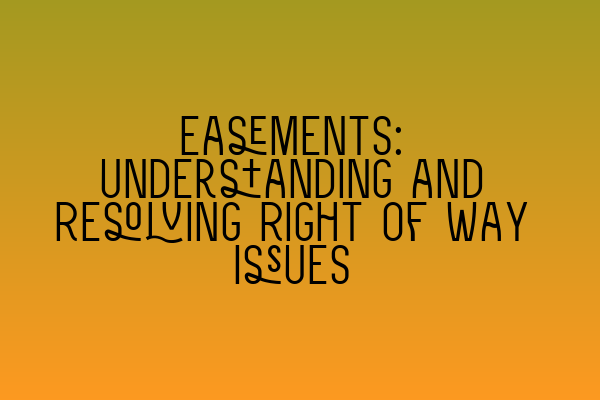Easements: Understanding and Resolving Right of Way Issues
As solicitors specializing in property law and land law, we frequently encounter cases involving easements and right of way disputes. Understanding the intricacies of easements is crucial in providing effective legal advice and resolving these issues for our clients. In this blog post, we will delve into the concept of easements, explain their importance, and provide insights on how to tackle right of way disputes.
What are Easements?
An easement is a legal right that grants a person or entity the right to access or use another person’s land in a specified manner. It creates a legally enforceable interest in the land and can be advantageous to both the grantor and the grantee. Common examples of easements include rights of way for access, rights to light, and rights to drainage.
Importance of Easements
Easements play a significant role in ensuring the smooth functioning of properties and land. They provide necessary access to necessary utilities, such as electricity, water, and gas, for both residential and commercial properties. Without easements, properties could be landlocked or hindered in their development, leading to adverse consequences for property owners.
Resolving Right of Way Issues
Right of way disputes can arise when there is a disagreement over the use or access to a particular route or pathway on someone else’s property. These disputes can disrupt the peaceful enjoyment of a property and can often escalate into legal conflicts. However, with the proper legal guidance and expertise, these issues can be resolved in a fair and satisfactory manner.
- Identify the boundaries: The first step in resolving right of way issues is to clearly identify the boundaries of the properties involved. This requires a thorough examination of the property deeds, plans, and any relevant documents.
- Review the easement documentation: It is essential to review any easement documentation to understand the rights and obligations of all parties involved. This includes checking for any restrictions or conditions that may affect the use of the right of way.
- Negotiate and mediate: In many cases, it is possible to negotiate and mediate a resolution between the parties involved. Engaging in open and honest discussions, facilitated by a skilled mediator, can often lead to a mutually acceptable agreement.
- Consider alternative dispute resolution: If negotiations do not yield a satisfactory outcome, alternative dispute resolution methods, such as arbitration or adjudication, can be explored. These methods provide a cost-effective and efficient way to resolve the dispute without resorting to lengthy court proceedings.
- Seek court intervention: In cases where negotiations and alternative dispute resolution methods fail, seeking court intervention may be necessary. A court can hear the evidence and make a legally binding decision to resolve the right of way dispute.
At SQE Property Law & Land Law, we have extensive experience in dealing with easements and right of way disputes. Our team of expert solicitors are well-versed in the intricacies of property law and can provide practical solutions tailored to our clients’ needs.
